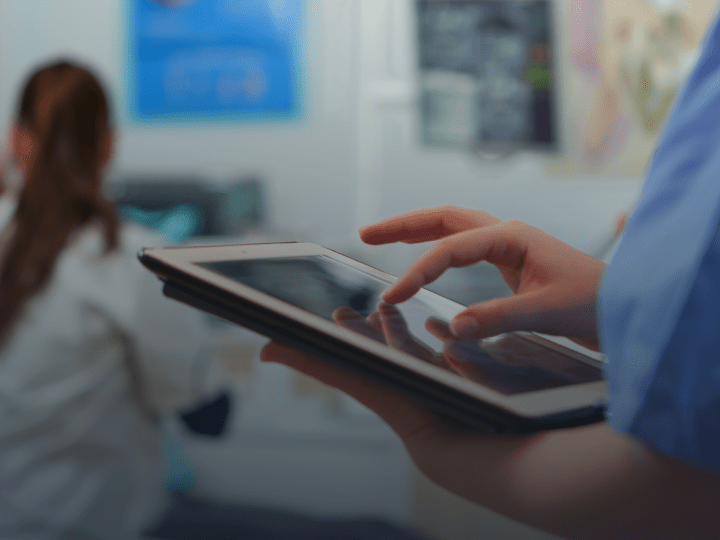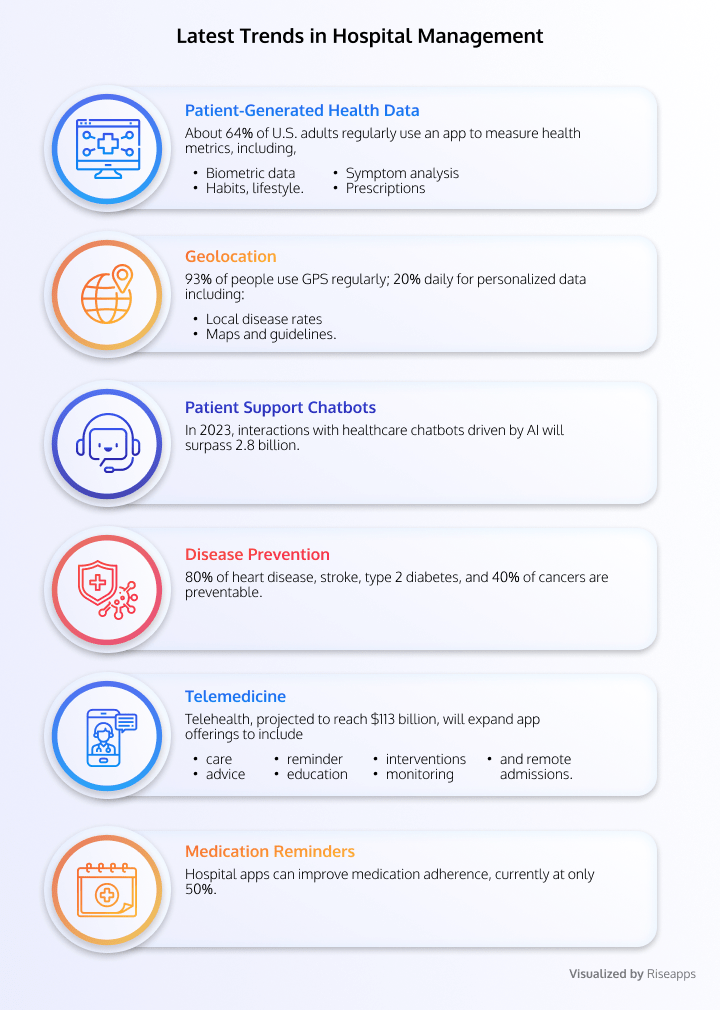Hospital App Development: Nailing Your MVP Costs, Steps, & Features

So, you’re aiming to whip up a hospital app. But how do you build an MVP, pick the right features, shell out the cash, or map the steps? It’s a head-scratcher.
Running a hospital is no cakewalk. You need spot-on communication, top-tier care, and rock-solid handling of data.
Without a tight management game plan, healthcare joints hit roadblocks tech-ing out. That’s why lots of them are stuck in the past with their operations, causing hang-ups, overheads, and crossed wires.
Your hospital could hit the jackpot with the right app. We’re here to give you the lowdown on planning, funding, and managing your hospital app development. Let’s first ramp up the current trends shaking up hospital management.
What’s Hot in Hospital Management: The Latest Trends
Before you jump into crafting your healthcare app, it’s crucial to catch the current trends. These trends determine your app’s cool factor among users and its competitiveness in the Mhealth market. Here are the hottest trends that meet user expectations.

Patient-Generated Health Data is the New Black
About 64% of U.S. adults are now measuring their health metrics via an app. Patient-generated health data is all the rage. These apps pull in user stats like heart rate and more from their phones or wearables. In essence, they’re turning paper medical records digital and keeping tabs on the user’s health in real time. This kind of data might encompass:
- Biometrics
- Lifestyle specifics
- Disease symptoms
- The prescribed treatment plan
These apps are like a two-way street connecting the patient and the clinic, enabling doctors to make decisions with all the facts and share patient info with other specialists.
Geolocation – Finding Your Way in Healthcare
In 2022, 93% of folks leaned on their maps/GPS – with one in five using it daily. Geolocation is making waves in Mhealth apps too. It aids users in locating the nearest pharmacies and hospitals and also enables more tailored info delivery, like local disease stats and guidelines.
Chatbots for Patient Support
Patients aren’t looking to dial their doctors for an appointment. They’re all about scheduling a slot, getting personalized advice, and test results via messengers. Healthcare chatbots are the ticket here. According to Juniper Research, interactions with healthcare chatbots powered by AI are set to exceed 2.8 billion annually by 2023.
AI: Your New Wingman in Fighting Off Diseases
In the healthcare industry, time literally saves lives. To up their game in disease detection and prevention, hospitals are employing AI, machine learning, and neural networks for in-depth predictive analysis at breakneck speed. These algorithms can crunch enormous amounts of data faster and with more precision than any human.
The Rise of Telemedicine and RPM
We hustled an ABM study on telehealth app development and picked the brains of 13 CEOs to figure out their business views, tips, struggles, and shortcomings. Our take? Remote patient monitoring (RPM) is stealing the show, making up 38% of the big waves about to hit healthcare in 2023.
Telehealth, a broader area, is also skyrocketing in the healthcare IT industry and is projected to soar to $113 billion by 2025. This tech enables hospitals to deliver medical assistance and consultation via video and chat, ditching the long wait times. Telehealth’s versatility extends to every medical field, from mental health services and psychiatry to diagnosis and treatment. Telemedicine is a handy tool for services like:
- Care
- Advice
- Reminders
- Education
- Intervention
- Monitoring
- And even remote admissions
Medication Reminder Apps are Stepping into the Spotlight
Sadly, patients only stick to 50% of chronic disease meds. Medication reminder apps can help tackle this issue. These apps often feature:
- The patient’s name
- Info about each drug
- Dose, side effects, and reactions
- Guidelines on when and how to take the meds
When it’s time to pop the pills, the app pings a reminder to the patient. This enables hospitals to monitor both regular and as-needed medication intake.
Cash-In Strategies for Hospital Apps
Hospital apps don’t stray far from regular apps when it comes to making revenue. Pick a strategy that aligns with your business game plan and needs. Here’s a peek at your options:
Freemiums
It’s all about the bait and switch. Give patients a freebie version with just the basics. If they want the full shebang with premium features, they pay for it.
Ad Space
You’ve got digital billboard space right there in your app. Let other businesses splash their ads on it, and you can charge them on a per-click, per-action, or per-view basis.
Premium Content
This one’s a winner for peer-to-peer apps. Give users a taste with some free content. But for the real deal or fresh updates, they will have to pay to play.
Subscriptions
The subscription model’s a big-league player in the app monetization game. Get doctors on board with paid listings for a limited time. When their time’s up, they’ll need to renew to stay visible in the app search.
Transaction Fees
If you’re thinking of a two-sided marketplace where patients are paying specialists through your app, consider transaction fees. You can take a cut of 5% to 10% on in-app payments, depending on the total.
Hospital App Development: From Brainwave to Beta Version
A fully integrated and meticulously designed app can serve as the nerve center for your hospital. This requires a native approach to app development, meaning your software engineers will need to tailor the app to each operating system right from ground zero.
We’re dishing out the key phases of healthcare app development, so you’re in the loop before we hit the ground running.

Picking the Right Hospital Mobile App Type
Hospital mobile apps come in a buffet of types, each with its own mission, user base, and feature list. To sculpt your app, you’ve got these options on the table:
Database Hospital Apps
These apps serve as a one-stop shop for patients to stow their personal info, medical histories, and treatment plans.
Example: Epocrate.
Doctor Networking Apps
Apps where physicians can swap notes, build a community, seek advice, and more.
Example: DailyRounds.
Health Tracking Apps
These apps empower doctors to keep tabs on a patient’s recovery, and compile test results and other medical paperwork.
Example: Medisafe.
Scheduling Apps
Booking apps cut back on paperwork and make scheduling patient appointments a breeze.
Example: Zocdoc.
Video Conferencing Apps
These apps function like two-way markets, letting patients pencil in live chat sessions or video-call consultations.
Example: Doctor-on-demand.
Rounding Up a Winning Hospital App Development Team
When you’re scouting for a hospital app development crew, you’ve got to weigh in on several aspects:
Specialized Experience
Top of the list is the team’s track record in healthcare app development. Crafting a hospital app demands a solid grasp of healthcare laws, patient privacy norms, and medical jargon.
A crew with experience in hospital apps will be better equipped to navigate the healthcare industry.
Technological Chops
The team should be well-versed in the hottest app development tech and methods. They should be able to build a cross-platform app that runs seamlessly across different devices and operating systems.
Plus, they should know their way around advanced features like AI and machine learning, which can turbocharge the app’s capabilities.
Security Compliance
Given the sensitive nature of patient data, the team needs a deep understanding of healthcare data security standards like HIPAA in the US or GDPR in Europe.
They should be adept at incorporating strong data encryption and secure user authentication techniques to safeguard patient data.
Post-Launch Support
Once the app is up and running, it’ll need routine updates and maintenance to keep it in top form. So, make sure your team offers reliable after-launch support services.
Communication and Teamwork
Clear communication and teamwork are essential to pulling off a successful project. Hunt for a team that’s receptive to feedback, quick to respond, and transparent in their workings.
Integrate UX/UI Design Elements and Develop the Hospital App MVP
UX design is all about boosting user satisfaction by making the app easy to use and navigate. For a hospital app, this could mean creating a streamlined process for booking slots, easy-to-find health info, or a swift way to pull up medical records. UX design involves deep-diving into user needs and preferences, followed by wireframing, prototyping, and user testing to vet the designs.
While UX zeroes in on the user’s journey, UI design deals with the app’s visual vibe. It tackles the visual elements of the app, including color schemes, button placements, font choices, and icon design. A solid UI design should be easy on the eyes and consistent, making the app visually intuitive and simple to grasp at first glance.
Once the UX/UI designs pass muster, the MVP development can kick off. The MVP is a stripped-down version of the app, packing just the basic features that solve the user’s core problems. It allows developers and stakeholders to collect user feedback early on in the development journey and tweak the app on the fly.
Building the hospital app MVP with a solid UX/UI design base ensures the user’s needs stay in the spotlight, culminating in an app that delivers a seamless, efficient, and enjoyable experience. This user-centric approach allows the developers to incorporate the most important features. These include:

Features for Patients:
Appointment Scheduling
Lets patients pencil in, reschedule, or nix appointments with docs.
Prescription Management
Keeps track of medication schedules and refills.
Health Records Access
Grants access to personal health records and lab results.
Virtual Consultations
Opens the door to telemedicine appointments with healthcare providers.
Billing and Payment
Facilitates the digital payment of medical bills.
Reminders
Pings notifications for medication, upcoming appointments, and preventive care.
Features for Healthcare Providers:
Patient Management
Provides quick access to a patient’s medical history, current meds, and health records.
Appointment Management
Helps keep tabs on upcoming appointments and schedule tweaks.
Prescription Writing
Facilitates digital scribbling of prescriptions, cutting down on errors.
Patient Monitoring
Allows tracking of patient’s health progress over time.
Peer Collaboration
Offers a platform to discuss complex cases with peers.
Features for Administrative:
Staff Scheduling
Makes creating and managing staff schedules a piece of cake.
Billing and Insurance
Handles billing, insurance claims, and payment processing.
Reporting
Assists in generating reports on hospital activities, patient turnover, and finances.
Inventory Management
Keeps track of and manages medical supplies and medication stocks.
Patient Admission and Discharge
Streamlines the workflow of patient admission, transfer, and discharge.
Test and Improve
In the testing and improving phase, the developed hospital app undergoes stringent testing to sniff out and fix any bugs or glitches. This isn’t limited to just functional elements – usability testing also checks if the app is user-friendly and meets user needs.
Plus, security tests are conducted to make sure the app aligns with data privacy and protection norms.
Feedback from these tests is used to fine-tune the app, ensuring it’s efficient, intuitive, and dependable before it hits the market. This cycle of testing and improving is key to delivering a user-focused app.
Launch Your App and Collect Feedback
Once your hospital app MVP is good to go, it’s time to upload it to app marketplaces for your patients to download.
Solicit feedback from your patients about the app’s functionality, design convenience, and potential new features. This will give you a clearer picture of whether your app hits the mark or not.
The final step involves launching your app on the right platforms. This means deploying the app on platforms like Google Play Store for Android users and the Apple App Store for iOS users.
During this stage, you have to consider factors like the platform’s guidelines, the app’s compatibility with different operating systems, and version control.
How Much Does It Cost to Develop a Hospital App?
Developing a hospital app isn’t a one-price-fits-all deal. The final cost depends on the feature list, supported platforms, back-end integrations, team size, and developer hourly rates.
Ballpark figures? You’re probably looking at anywhere from $90,000 to $250,000 for a full-blown hospital app, based on our experience.
Now, let’s look at some bumps you might hit on the road.
Preparing for Challenges in Hospital App Development
Building a hospital mobile app is no picnic. You’ll need a tech partner that can go the distance and handle the following curveballs:
Locking Down Data
Number one is security and compliance. You should keep patient data under lock and key and play nice with privacy laws like HIPAA stateside and GDPR across the pond. It’s about beefing up with stuff like encryption, secure login, and controlled data access.
Juggling Data Integration
Data<a href=”https://riseapps.co/ai-integration-business-efficiency”>AI integration</a> and working with other systems can be a tough nut to crack. Your hospital app has to integrate with existing healthcare systems and their unique data formats. It’s all about smooth data flow and accessibility, and your developers need to have a game plan for it.
User Interface and Experience
Good UI/UX design is among the critical aspects of your app’s success. It ought to be a balancing act to keep the interface simple, navigable, and packed with features. Your designers need to hit the books, test things out, and keep tweaking until they nail it.
Size Up-Scaling Matters
Your app should grow with the demand. As more users hop on and data traffic picks up, the app needs to roll with it without performance dips. Your devs need to fine-tune the app’s architecture, backend, and database management to ensure it scales well.
Playing Well with Stakeholders
You’ll be working with a mixed bag of stakeholders, from healthcare providers and administrators to IT personnel and patients. Get everyone on the same page, get their buy-in, and work together.
Regulatory Approval and Compliance
Depending on your neck of the woods, your app might need a green light from regulatory bodies before it can hit the market. It should tick the boxes for safety, efficacy, and quality standards. Make sure your developers know the rule book inside out and stay on the right side of the law.
Riseapps’ Cases in Developing Hospital Mobile Apps: Over $100 Million Raised
At Riseapps, we’re pushing the limits and boosting the bottom line in the healthtech world. We’ve been doing our thing for over six years, helping our clients score big with investments through projects that solve a real problem.
Check out a few examples of our success in hospital app development:
Black Doctor
Black Doctor 24/7 uses the power of a virtual assistant to change the game in telemedicine. It’s all about improving the doctor-patient relationship, reducing healthcare disparities, and tackling cardiovascular disease treatment.
We stepped up to the plate with:
Black DoctorMobile and Web UI/UX Design
Our designers cooked up some user-friendly interfaces for the doctor and patient apps.
AI Assistant Development
We built in Amina, a 24/7 virtual assistant that helps cut service time and minimize COVID-19 exposure.
Third-Party Integration
We hooked up services like Agora for telemedicine, GetStream for chat, and Infermedica API for AI help.
The result? We developed a killer app that:
- Cuts care costs by 40%
- Ramps up doctor efficiency tenfold
- Ensures 100% HIPAA compliance
- And speeds up patient bookings by 3x.
InteliWound (Now Wound Synergy)
InteliWound is a HIPAA-compliant wound management software that raises the bar for wound care. It’s a game changer for physicians and nurses, helping with clinical assessment, treatment planning, and supply ordering.
Here’s how we made it happen:

3D Scan and Assessment
The app uses top-notch camera tech for rapid, volumetric measurement of wounds.
Treatment Suggestions
Thanks to a custom algorithm, Intelliwound suggests treatments, leaving the final call to the pros.
Oversight and Supply Chain Integration
With a real-time, cloud-based system, we’ve streamlined oversight and supply chain integration.
The payoff?
- Faster wound care for US patients
- Fewer treatment visits
- Improved medical outcomes
- And increased financial returns for healthcare organizations.
Wrapping up
Hospital mobile apps are a big win for patients and doctors. They help keep tabs on recovery progress, offer at-home consultations, and keep patient info in one spot. Plus, with machine learning and AI, quick disease diagnosis and effective treatments are at your fingertips.
Considering your own hospital mobile app? No need to break the bank upfront. Start small with a Minimum Viable Product (MVP) and grow from there.
FAQ
What are the must-have features of a hospital Mobile App?
A hospital mobile app should have appointment scheduling, EHR access, prescription management, telemedicine features, push notifications, and a payment gateway.
What is the average cost of hospital app development?
The average cost of developing a hospital app can vary widely, depending on features and complexity, ranging from $90,000 to $250,000.
Should you opt for a custom hospital app or an off-the-shelf one?
Choosing between a custom hospital app or off-the-shelf depends on your specific needs. But we recommend a custom app if you require a unique feature set aligned with your workflow.
Contact Us





